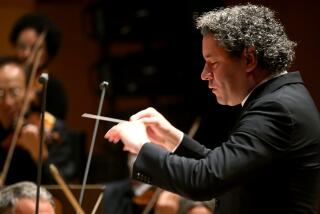Svendsen, Tosti, Uccellini: A Trio of Rare Delights
- Share via
It’s a minor miracle that the recording companies are still capable of pulling off repertory surprises. No, not another definitive reinterpretation on absolutely authentic instruments of the ur-ur version of some familiar work, but a recording of worthwhile music that has escaped the notice of the A&R; people altogether or of once-familiar material fallen into neglect for no perceptible reason beyond changes in fashion.
Last year, Deutsche Grammophon made somewhat of a splash with its hyping, via dazzlingly accomplished performances from Musica Antiqua Koln, of an obscure German Baroque composer named Johann David Heinichen. Part of the critical community hailed him as the “new” Handel, or Bach or Vivaldi. To these ears, his stuff sounded like Vivaldi rejects, which might be interpreted as a double insult.
There’s more substance and originality, if far less flash, in the works of Marco Uccellini (1610-1680), an Italian composer whose name and music were unknown to this listener prior to the recent release of “La Bergamasca” (Harmonia Mundi 907066), a collection of brief, harmonically pungent dances in superbly vital performances by the Arcadian Academy, who are members of San Francisco’s Philharmonia Baroque Orchestra, directed from the keyboard by Philharmonia’s music director, Nicholas McGegan.
Uccellini, an employee of the cathedral of Modena and the Farnese court in Parma, scored these dance-inspired pieces for one or two violins (here, Elizabeth Blumenstock and Katherine Kyme), with the continuo assigned by McGegan variously to cello (David Bowles), archlute or guitar (David Tayler) and harpsichord or organ.
Uccellini shows himself to have been a master of variation form and an inventive melodist in these 18 brief dances, which are about equally divided between the lively (the title tune is an irresistible toe-tapper) and the gravely elegant.
A much later Italian-born composer, Francesco Paolo Tosti, wrote some of Victorian England’s greatest hits in addition to serving as singing teacher to the British royal family.
His ties with England notwithstanding--he became a British subject in 1906 and was knighted two years later--Tosti’s music was quintessentially Italian, represented by such evergreens as “La Serenata,” “A vucchella,” “Ideale,” “L’ultima canzone,” “Mattinata” and “Non t’amo piu.”
These exquisitely refined, intimate songs, long abused by operatic golden throats backed by lush symphony orchestras, are restored to their pristine grace via the sweet and true tenorino and sensitive word-pointing of Peruvian-born Ernesto Palacio (Arkadia 125.1).
The songs, originally piano-accompanied, are presented here in evocative, period-style arrangements employing varying combinations of piano, violin, flute, guitar, harp and cello.
If the Norwegian composer Johan Svendsen is remembered at all it is for his erstwhile salon favorite, the lovely Violin Romance in G.
There is nothing even faintly “important” about Svendsen’s music, but it does possess, like that of his older countryman, Edvard Grieg, a certain yearning, undemonstrative sweetness that we have come to regard as typically Scandinavian.
The Romance is executed with winning simplicity by Kenneth Sillito and his colleagues of the Academy of St. Martin in the Fields Chamber Ensemble. But on the same CD (Chandos 9258), Svendsen shows himself capable of filling out a more substantial form with his appealingly sentimental lyricism: a String Octet in A, otherwise unavailable on recordings.
The rare and faultlessly presented program from the Academy players also includes the folksily tuneful String Quintet in G of the 23-year-old Carl Nielsen. It offers no hint of the harmonic originality or rhythmic complexity of the later, symphonic Nielsen, but there are flashes of the quirky composer-to-come in the handsomely crafted opening movement’s darting forays into distant, usually minor, keys.
More to Read
The biggest entertainment stories
Get our big stories about Hollywood, film, television, music, arts, culture and more right in your inbox as soon as they publish.
You may occasionally receive promotional content from the Los Angeles Times.










